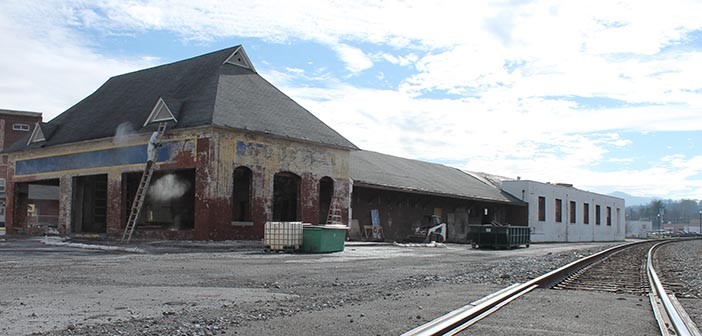By Jeff Keeling

A worker pressure washes away paint to reveal original brick at the former ET&WNC railroad depot. Photo by Jeff Keeling
As trains rattle by regularly along the Norfolk-Southern line in downtown Johnson City, signs of renewal are commonplace. Within a span of 300 yards along Brush Creek, the sound of heavy equipment and power tools confirms it: commerce, art and historic renovation continue combining to transform the historic heart of the city.
At 126 Buffalo Street, workers have moved from the outside to the inside of the 124-year-old building that originally housed the East Tennessee and Western North Carolina railroad depot. A building permit pulled Jan. 29 by GBW Construction is for a brewery “shell only,” with an estimated valuation of $200,000.
That would be for a brewery, bottling operation and restaurant, at least according to plans submitted to Johnson City’s planning office in early December. Shortly after the plan submittal, workers began stripping white paint from the building’s exterior to reveal the original red brick. The plans mention an 8,500-square-foot brewery in phase one, followed by a 2,000-square-foot bottling and display operation in phase two and a “future restaurant” of 1,700 square feet in phase three.
Sevierville businessman Joe Baker is developing the property, just as he did the Carolina, Clinchfield and Ohio depot across the road from the ET&WNC building that is now home to Tupelo Honey Cafe.
“The depots to me were an opportunity to come in and create a gathering place, and really serve as a catalyst for improving and building upon what is and always has been the downtown and the heart of the city,” Baker said Tuesday as several dozen people busily worked inside and around the depot.
While preliminary, the plans offer an intriguing glimpse into what should be a historically accurate renovation of a building that sits near ground zero of Johnson City’s birth – a building with a history of its own that epitomizes the city’s railroading heritage. A functional grain silo, bocce ball and bike racks, covered decks and lots of patio space appear set to mesh with restored brick, roofing and windows outside and retention of exposed steel roof trusses and other classic architectural elements inside.

Artists Duke Oursler, left, and Marc Moulton with their sculpture, “Genesis,” at the entrance to Founders Park. Photo by Jeff Keeling
“When you talk about the foundation of the city coming from the rail lines that were built here, and these old depots … if these buildings hadn’t been here, if the history wasn’t here, you can’t recreate it,” Baker said. “It’s here because it was important to the city at one time. Now, to be able to repurpose the buildings and do it in a positive way that creates jobs and revenue and energy and good things for the folks that live here – that’s a lot of fun.”
While he jokingly referred to the renovation projects as “an expensive hobby,” Baker said, “these things wouldn’t happen unless we believed that there was an opportunity both for us as landowners and also for the business owners that are moving into these spaces and are excited about the prospect of opening a business in downtown.”
He added that more specific details will be released sooner rather than later about the businesses that will occupy the depot.
“I’m excited about the next six months and seeing the doors open, and what I expect to develop as far as new retail businesses and a lot of fun things to do.”
About 500 feet west of the depot, near where Brush Creek now breaks into the open at the head of Founders Park, artists Duke Oursler and Marc Moulton looked on as city crews installed their two-piece, stainless and corten steel sculpture “Genesis” at the park’s west entrance. Art professors at Western Illinois and Georgia Southern universities, respectively, the pair teamed up to create the two-piece work commissioned by the city.
“We like doing big public artwork,” said Oursler as he put a few finishing touches on small pollinator animal figures – butterflies, dragonflies and the like – whose stainless steel design has been patinated by heat. The figures grace a 10-foot high stainless steel cone accentuated by holes and lit from within. Next to it stands a corten and stainless piece with Founders Park in large letters.
“The whole piece is based on pollination, and the beginning of Johnson City, which was pollinated right in this area,” said Oursler.
A few days after Oursler and Moulton departed, leaving their work to illuminate the night at Sevier Street, crews from E. Luke Greene were a mere stone’s throw from the depot, busy using backhoes to rip up asphalt at a city parking lot. That parking lot, and the site of a razed building, are where a soon-to-be-constructed “event pavilion” will become home to Johnson City’s farmers market – possibly before the end of the 2015 season.
The combination of private and public investment that has occurred over the last several years downtown has Baker bullish on the future.
“With private development outside of our properties, and also the work that’s been done on Founders Park and now the Farmers Market, we collectively, both the city and private development, are working together to create a special destination that I think will really serve the city well,” Baker said, “not only from a perspective of creating revenue but also just being a good place to live.”





